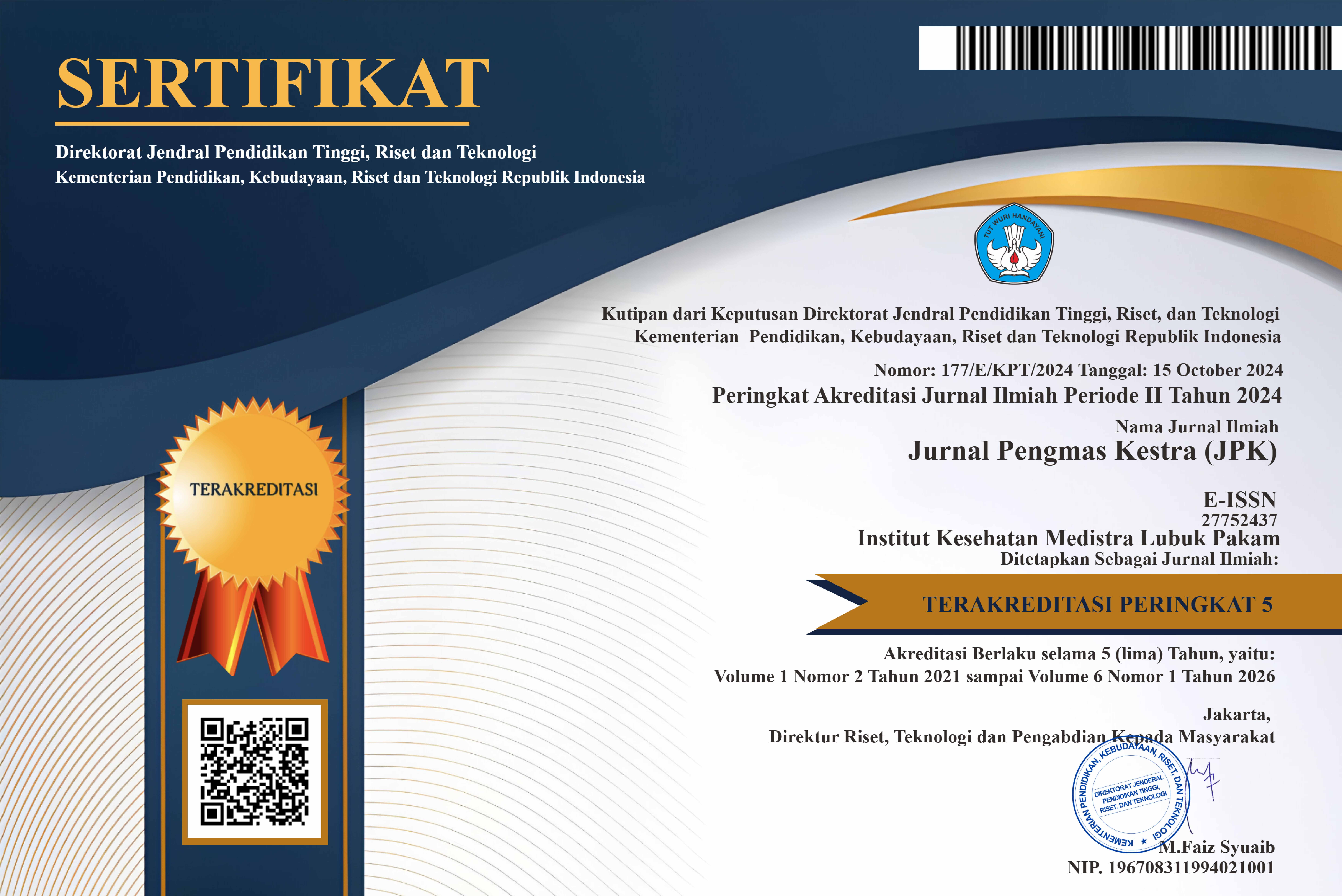Strengthening the Role of Family in the Management of Pressure Ulcers in Stroke Patients at Grandmed Hospital, Lubuk Pakam
DOI:
https://doi.org/10.35451/mmbqr630Keywords:
Stroke Patients, Empowerment, Family Role, Pressure Ulcer CareAbstract
Stroke is a type of catastrophic illness characterized by high incidence and disability rates. It significantly impairs physical function and increases the risk of developing pressure ulcers. Pressure ulcers, or decubitus ulcers, occur due to prolonged pressure, friction, and moisture exposure, leading to skin tissue damage in areas of the body that bear weight during periods of immobility. Family support plays a crucial role in the rehabilitation of stroke patients, particularly in providing basic care, assisting with mobility, and preventing complications. This community engagement program (PkM) aimed to enhance family capacity in managing pressure ulcers through educational and practical interventions. Family involvement was facilitated through structured education and hands-on training to encourage active participation in supporting comprehensive patient recovery. The PkM activities were delivered using an educational and participatory approach to 25 participants, all of whom were family members of stroke patients currently hospitalized at Grandmed Hospital, Lubuk Pakam. The program implementation consisted of four stages: preparation, sample selection, execution, and evaluation. The results showed a significant improvement in participants’ knowledge, with an average increase of 32.6 points (59.1%) regarding the role of families in pressure ulcer care. Additionally, 92% of participants demonstrated competency in performing basic stroke care, and 96% expressed high satisfaction with the program. This PkM initiative effectively strengthened the role of families in managing pressure ulcers in stroke patients, thereby contributing to increased patient motivation and improved quality of life.
References
[1] Amirsyah, M., Amirsyah, M., & Putra, Ulkus Dekubitus pada Penderita Stroke. Kesehatan Cehadum, 2(03), 1–8. 2020
[2] J. H. Lee, Y. S. Kim, and H. J. Choi, “Family-centered intervention for the prevention of pressure ulcers in stroke patients: A quasi-experimental study,” Journal of Clinical Nursing, vol. 27, no. 5–6, pp. e1095–e1104, Mar. 2018, doi: 10.1111/jocn.14160.
[3] Kementerian Kesehatan Republik Indonesia, Profil Kesehatan Indonesia Tahun 2022. Jakarta: Kemenkes RI, 2023.
[4] M. T. Fard, A. Malekzadeh, and R. Sadeghi, “The effect of family-based training on caregiving burden and knowledge about pressure ulcer in stroke patients,” Iranian Journal of Nursing and Midwifery Research, vol. 25, no. 2, pp. 139–144, 2020, doi: 10.4103/ijnmr.IJNMR_147_19.
[5] A. P. Whitty and L. Cusack, “Effectiveness of education interventions for family caregivers of older adults with pressure injuries: A systematic review,” International Journal of Older People Nursing, vol. 17, no. 1, e12402, Jan. 2022, doi: 10.1111/opn.12402.
[6] M. A. Qaseem et al., “Prevention and Management of Pressure Ulcers: A Clinical Practice Guideline From the American College of Physicians,” Annals of Internal Medicine, vol. 162, no. 5, pp. 370–379, Mar. 2015, doi: 10.7326/M14-1567.
[7] A. Coyer, L. Cook, and T. Loyd, “Pressure injury prevention in critically ill patients: A quality improvement project,” Journal of Wound, Ostomy and Continence Nursing, vol. 47, no. 5, pp. 441–447, Sep.–Oct. 2020, doi: 10.1097/WON.0000000000000680.
[8] E. Manahan and J. McIntyre, “Improving pressure injury outcomes through family engagement in care,” Advances in Skin & Wound Care, vol. 33, no. 10, pp. 558–563, Oct. 2020, doi: 10.1097/01.ASW.0000701250.89793.54.
[9] R. Chaboyer, D. Bucknall, A. Webster et al., “Targeted interventions to prevent pressure injuries in at-risk patients: A multicentre randomised controlled trial,” BMJ Quality & Safety, vol. 30, no. 5, pp. 404–410, May 2021, doi: 10.1136/bmjqs-2020-011345.
[10] Creswell, J. W., & Creswell, J. D. (2018). Research Design: Qualitative, Quantitative, and Mixed Methods Approaches (5th ed.). Thousand Oaks, CA: SAGE Publications.
[11] S. M. Park and H. Y. Kwon, “Family caregiver burden and quality of life in stroke survivors: A Korean perspective,” BMC Nursing, vol. 21, no. 1, pp. 1–9, Jan. 2022, doi: 10.1186/s12912-021-00767-1.
[12] Susilawati, F., & SK, N. (2018). Faktor Resiko Kejadian Stroke. Jurnal Ilmiah Keperawatan Sai Betik, 14
[13] A. Moore and M. Cowman, “Education for informal caregivers of older people with chronic wounds: A narrative review,” Journal of Tissue Viability, vol. 28, no. 3, pp. 139–145, Aug. 2019, doi: 10.1016/j.jtv.2019.06.001.
[14] A. S. Hassan, L. R. Fadillah, and T. Nursalam, “Family empowerment improves caring ability in pressure injury prevention of post-stroke patients,” Jurnal Ners, vol. 15, no. 1, pp. 67–74, Apr. 2020, doi: 10.20473/jn.v15i1.17155.
[15] N. Sari, E. Mulyadi, and D. Handayani, “Effectiveness of health education for family caregivers in preventing pressure ulcers in stroke patients,” International Journal of Nursing and Health Services (IJNHS), vol. 5, no. 1, pp. 12–19, 2022, doi: 10.35654/ijnhs.v5i1.199.
Downloads
Published
Issue
Section
License
Copyright (c) 2025 Syatria Wati, Yovi Fauzan, Samuel Ginting, Pratiwi Christa Simarmata, Debi Dinha Octora Sitepu

This work is licensed under a Creative Commons Attribution 4.0 International License.
Copyright in each article is the property of the Author.




















